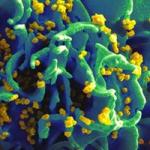
Sonja Marie Best, Ph.D.
Senior Investigator
Innate Immunity and Pathogenesis Unit
NIAID/DIR
Research Topics
The innate immune response is rapidly engaged after virus infection and functions to limit virus replication and mobilize adaptive immune responses. Viruses have evolved diverse strategies to suppress this critical host response and facilitate virus dissemination. In part, virus pathogenesis is a function of both the quality of the innate response evoked and the evasion strategies encoded by the invading pathogen. Thus, understanding the mechanisms underpinning immune activation and virus evasion will lead to improved vaccine design and novel therapeutics for treatment of both infectious and inflammatory disease.
Our current research program is shaped by the NIAID programmatic objectives in biodefense and emerging infectious disease research, namely basic research of pathogen biology and host response to develop effective vaccines and immunotherapeutics. We use flaviviruses (particularly members of the tick-borne encephalitis virus [TBEV] complex and West Nile virus [WNV]) as the primary model of infection to uncover novel cellular proteins requisite for antiviral innate immune responses and to identify virus-encoded mechanisms that antagonize these responses. These studies involve research of viruses at BSL2, BSL3 and BSL4. Our three main areas of research are outlined below.
Mechanisms utilized by pathogenic viruses to modulate host innate immunity. Type I interferon (IFN) is essential to protection from flavivirus infection and has been used clinically as a potential therapeutic, albeit with limit success. This may be due to the observation that all flaviviruses examined to date antagonize IFN-dependent responses by suppressing JAK-STAT signal transduction. We originally identified NS5 as the major IFN antagonist encoded by flaviviruses, initially using Langat virus (LGTV; a member of the TBEV complex of flaviviruses) and later using WNV. Although other nonstructural proteins contribute to suppression of JAK-STAT signaling, studies by our laboratory and others suggest that NS5 is the most potent of the IFN antagonist proteins encoded by all vector-borne flaviviruses examined thus far. Hence, determining the mechanism(s) by which NS5 impedes signaling is essential to understand flavivirus pathogenesis and may lead to new therapeutic targets.
The role of novel IFN-stimulated genes (ISGs) in host resistance to virus infection. It is important to understand the mechanisms underlying the anti-viral effects of IFN by identifying the function of ISGs with anti-viral activity. In particular, we are examining the role of tripartite motif (TRIM) proteins in host resistance to flavivirus replication. Many TRIM proteins are ISGs that mediate species-specific virus restriction or regulate host innate immunity. TRIM protein function is often dependent on their E3 Ubiquitin ligase activity. Therefore, we are also examining the role of ubiquitin in flavivirus replication and immune evasion.
The importance of dendritic cell (DC) function to anti-viral innate and adaptive immune responses. It is essential to translate our findings to immunologically relevant cell types and animal models to understand the roles that induction and evasion of innate immunity has in development of adaptive immunity and in virus pathogenesis. We are using primary DCs and animal models to examine the importance of DCs as initial targets of infection, the role of DC pathogen recognition receptors in the immune response to infection, and how the mechanisms utilized by flaviviruses to modulate DC function affect adaptive immunity and virus pathogenesis.
Biography
Dr. Best received her Ph.D. in biochemistry and molecular biology from the Australian National University where she studied the pathogenesis of myxoma virus, a poxvirus. She conducted her postdoctoral research at Rocky Mountain Laboratories (RML) on the complex role of apoptosis in the replication of parvoviruses. She stayed at RML as a Research Fellow and then a Staff Scientist to investigate virus-host interactions involved in flavivirus pathogenesis. It was during this time that she developed her interests in innate immunity and the molecular mechanisms utilized by flaviviruses to evade these critical host responses. In 2009, Dr. Best established an independent laboratory as a tenure-track investigator to expand her studies on interactions between pathogenic viruses and the host immune response. In 2011, Dr. Best was awarded a Presidential Early Career Award for Scientists and Engineers for her work on flavivirus suppression of innate immune responses.
Selected Publications
- Robertson SJ, Bedard O, McNally KL, Shaia C, Clancy CS, Lewis M, Broeckel RM, Chiramel AI, Shannon JG, Sturdevant GL, Rosenke R, Anzick SL, Forte E, Preuss C, Baker CN, Harder JM, Brunton C, Munger S, Bruno DP, Lack JB, Leung JM, Shamsaddini A, Gardina P, Sturdevant DE, Sun J, Martens C, Holland SM, Rosenthal NA, Best SM. Genetically diverse mouse models of SARS-CoV-2 infection reproduce clinical variation in type I interferon and cytokine responses in COVID-19. Nat Commun. 2023;14(1):4481.
- Ponia SS, Robertson SJ, McNally KL, Subramanian G, Sturdevant GL, Lewis M, Jessop F, Kendall C, Gallegos D, Hay A, Schwartz C, Rosenke R, Saturday G, Bosio CM, Martens C, Best SM. Mitophagy antagonism by ZIKV reveals Ajuba as a regulator of PINK1 signaling, PKR-dependent inflammation, and viral invasion of tissues. Cell Rep. 2021;37(4):109888.
- Chiramel AI, Meyerson NR, McNally KL, Broeckel RM, Montoya VR, Méndez-Solís O, Robertson SJ, Sturdevant GL, Lubick KJ, Nair V, Youseff BH, Ireland RM, Bosio CM, Kim K, Luban J, Hirsch VM, Taylor RT, Bouamr F, Sawyer SL, Best SM. TRIM5α Restricts Flavivirus Replication by Targeting the Viral Protease for Proteasomal Degradation. Cell Rep. 2019;27(11):3269-3283.e6.
- Grant A, Ponia SS, Tripathi S, Balasubramaniam V, Miorin L, Sourisseau M, Schwarz MC, Sánchez-Seco MP, Evans MJ, Best SM, García-Sastre A. Zika Virus Targets Human STAT2 to Inhibit Type I Interferon Signaling. Cell Host Microbe. 2016;19(6):882-90.
- Giraldo MI, Xia H, Aguilera-Aguirre L, Hage A, van Tol S, Shan C, Xie X, Sturdevant GL, Robertson SJ, McNally KL, Meade-White K, Azar SR, Rossi SL, Maury W, Woodson M, Ramage H, Johnson JR, Krogan NJ, Morais MC, Best SM, Shi PY, Rajsbaum R. Envelope protein ubiquitination drives entry and pathogenesis of Zika virus. Nature. 2020;585(7825):414-419.
Related Scientific Focus Areas

Microbiology and Infectious Diseases
View additional Principal Investigators in Microbiology and Infectious Diseases




This page was last updated on Tuesday, August 15, 2023